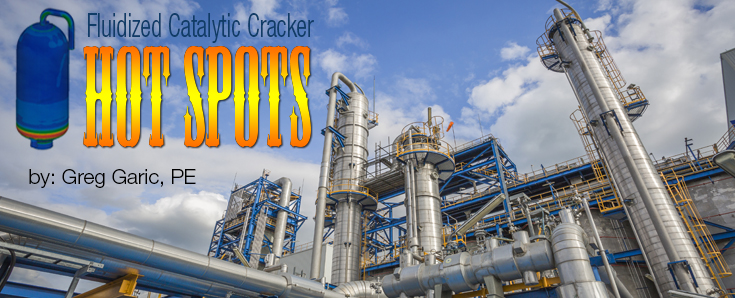Fluidized Catalytic Cracker Hot Spots

A far-too-frequent phenomenon seen in the refining world is the development of “hot spots” in the fluidized catalytic cracker (FCC). The damage can occur in the catalyst dump line or regenerator. These refractory lined vessels run very hot with regenerator internal temperatures in the range of 1,300°F to 1,400°F. However, these are typically “cold wall” designs where the temperature at the outer wall is usually in the 300°F to 400°F range.
In the event of a local refractory failure, the wall can develop a “hot spot”. Refractory failures are typically progressive. While time alone can be enough to result in enlargement of the area of damaged refractory, shut-downs, with their inevitable thermal cycles, can significantly accelerate this process. This leads to a hot spot of increasing diameter and/or temperature.
As a hot spot reaches or exceeds the design temperature of the shell (usually around 650°F), the first line of defense for operators is steam cooling. Typically, a number of steam lances are positioned to blow steam onto the hot spot, which will produce a significant cooling effect. In this way, a hot spot that would otherwise (i.e., without steam) reach 1,200°F or higher can often be cooled to a surface metal temperature near, or below, the 650°F design limit.
However, given enough time, hot spots will usually become more severe and eventually reach a point where the surface temperature exceeds the design temperature and continues to climb. At this point, a number of actions are required, such as evaluation of the temperature limit and possibly design of an enclosure.
Evaluation of Temperature Limit
Most refineries perform regular infrared (IR) scans on the FCC shell. Close monitoring of the area begins after a routine IR scan indicates a warming spot slightly higher than the surrounding material. These warm spots are typically indicative of the beginnings of a local refractory failure. The warm spots are then monitored for weeks or months until their temperature begins to approach the original design temperature limit.
The two important questions to answer are:
- How high can the hot spot temperature rise without compromising safety?
- How long can the hot spot remain at that temperature?
Answering these questions requires a fitness-for-service (FFS) assessment that addresses (1) strength and (2) creep.
Strength Analysis
At increasing temperature, the strength of the shell material decreases. At some elevated temperature, the strength of the material will be so compromised that the integrity of the wall cannot be maintained. API 579-1/FFS-1, Fitness-for-Service (API 579) and (by reference) the ASME Boiler and Pressure Vessel Code, Section VIII, Division 2 (Div 2) provide guidance on how to evaluate the strength of the wall at elevated temperature.
Several stress analysis options are available including elastic, limit-load, or elastic-plastic collapse analysis (E-P). Today, most analysts opt for the simpler limit-load or E-P analysis. In any case, the hot spot area is evaluated by determining the load at which failure would be expected, and then reducing the failure load by some “design factor.” By iteration, this analysis can provide the maximum allowable temperature for the hot spot.
It is often seen that this type of detailed analysis results in an allowable maximum temperature significantly higher than the original design temperature. However, this analysis only accounts for the static load-carrying capacity of the material—it does not account for the time-dependent creep of the material at the elevated temperature.
Creep Analysis
“Creep” is the time-dependent deformation of a material under load. This phenomenon is different from plastic deformation. At high temperatures, it can occur at very low levels of stress.
Creep generally begins at a temperature around 40% of the absolute melting temperature of the material. API 579, Table 4.1 provides a list of materials and the corresponding temperature for the onset of creep.
At a given temperature in the creep range and with a given stress, a material will experience ever-increasing creep strain until the material eventually fails. Prediction of this time-to-failure is the essence of creep analysis.
A number of different methods are available for calculating the creep life. Two of the most popular are the Omega method and the Larson-Miller method. Both methods are described in API 579.
Application of either method to hot spot analysis involves calculating the time to failure of the hot spot at the hot spot temperature. However, at least two complications must be considered.
- Bulging – The hot spot may undergo significant bulging as it creeps. This changes the stresses in the area of the bulge, both at the crown and edge of the bulge.
- Temperature increase – The temperature may not be constant over time.
A creep life analysis is performed taking the above factors into account, and results in an estimated creep life for the hot spot.
Strength or Creep: Which Controls?
At higher stress but lower temperature, the strength analysis may control. However, as the hot-spot temperature rises more significantly into the creep range, creep will typically limit use of the hot spot.
Remediation
Sometimes a hot spot can be successfully cooled with steam until repair can be scheduled (i.e., the next TAR). However, hot spots often grow more severe at a rate that precludes waiting until the next TAR. In these cases, some type of engineered repair is needed.
Hot spots can be encapsulated, thereby creating a new pressure boundary. These encapsulations can be either hot wall repairs (using high-temperature material) or cold-wall repairs (creating a refractory-filled box). In either case, the design must be evaluated to consider how the dimensions of the hot spot may change in the presence of the encapsulation, as well as the creep and strength properties of the encapsulation and its welds.
This analysis is fairly sophisticated. It must simulate the heat leakage through the damaged refractory as well as through the surrounding undamaged refractory. It must include heat transfer analysis to establish an expected temperature profile. Finally, it must include stress analysis to determine if the enclosure meets the strength requirements of API 579.
Nonlinear Effect of Stress and Temperature
Creep life is extremely sensitive to both stress and temperature. Very rough rules of thumb are that:
- A 25°F increase in temperature will halve the creep life, and
- A 10% increase in stress will halve the creep life
Thus, if the temperature increases by 100°F, the creep life would be expected to be reduced to approximately 1/16 of the original creep life!
This behavior is significant where steam cooling is used to cool the hot spot area. It is not uncommon to occasionally turn off the steam for short periods to measure the hot spot temperature or install thermocouples. If the temperature without steam cooling rises significantly, the predicted creep life at the uncooled temperature could be a matter of hours or even minutes. Thus, interruption of steam cooling must be accompanied by temperature monitoring along with strength and creep assessment.
Temporary Repair
Once successfully installed, an enclosure constitutes a temporary repair. It no longer requires steam cooling and can itself be monitored with thermocouples or IR for changes in the metal temperature.
Such enclosures have been successfully used to remediate FCCU hot spots for periods in the range of 2 years or more.

Greg Garic, PE – Principal, New Orleans Office
Greg Garic has over thirty-five years of experience in analysis and fitness-for service assessment. He has spent most of his career working in the areas of structural integrity assessment and remaining life evaluation of pressure vessels and piping. He has served as a member of numerous ASME Committees, Subcommittee, and Task Groups. He is also an associate editor of several PVP volumes relating to fracture mechanics and fitness-for-service issues. He is also the author of Inspectioneering Journal’s monthly Fitness for Service Forum.




Leave a Comment
You must Register or Login to post a comment.